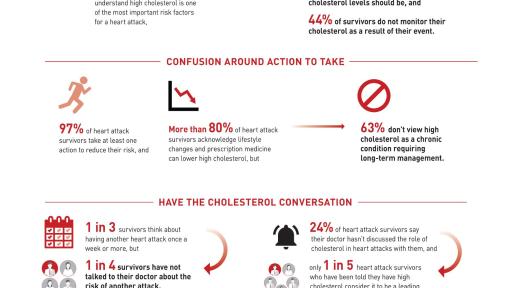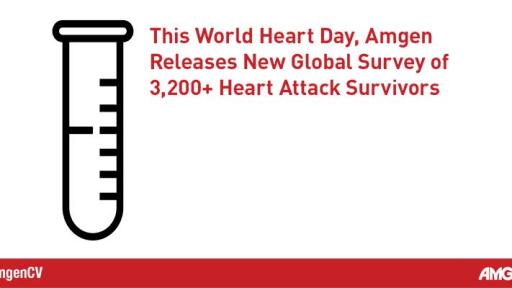Heart Attack Survivors Are Taking Steps To Reduce Their Cardiovascular Risk. But Are They The Right Ones?
This World Heart Day, Amgen is Releasing Results of a Global Survey of 3,200 Heart Attack Survivors Conducted Across 13 Countries
Close to Half of Survivors Are Not Monitoring Their Cholesterol Regularly
THOUSAND OAKS, Calif., (Sept. 26, 2019) – In recognition of World Heart Day on Sunday, September 29, Amgen (NASDAQ:AMGEN) today released findings from a global survey that evaluated worldwide heart attack survivors’ perceptions and awareness of the connection between cholesterol and cardiovascular (CV) events.
Globally, patients who have had a heart attack or stroke have a 1 in 3 risk of having another CV event.1 Lipids, such as low-density lipoprotein cholesterol (LDL-C), or “bad” cholesterol, are one of the most important risk factors for heart attack.2,3
The survey’s findings show that while heart attack survivors are proactively trying to improve their cardiovascular health, they may not fully understand the importance of lowering high LDL-C to reduce their risk of another heart attack:
- 97% of heart attack survivors surveyed say they are taking at least one key action to try to lower their risk, and 75% have talked to their doctor about the risk of another event.4
- However, confusion remains when it comes to lowering cholesterol. One-third do not know what their cholesterol levels should be and 44% are not monitoring their cholesterol regularly; only one in five heart attack survivors who have been told they have high cholesterol consider it to be a leading risk factor for another event.4
“The vast majority of heart attack survivors are taking some action to lower their risk of another event, but the issue is that most are not monitoring or managing all modifiable risk factors,” said Darryl Sleep, M.D., senior vice president, Global Medical and Chief Medical Officer at Amgen. “We’re using this World Heart Day to urge all people who are high-risk, like heart attack survivors, to speak with their doctor about the link between cholesterol and heart attacks, and how they can lower their cholesterol levels.”
Key survey findings – which included over 3,200 people in the United States, Mexico, Brazil, Canada, United Kingdom, France, Germany, Spain, Italy, the Netherlands, China, South Korea and Japan – revealed that patients might not be having the right conversations with their doctors.
- 63% of surveyed patients do not believe high cholesterol is a chronic condition requiring long-term care, and 24% of survivors say their doctor has not discussed the role of cholesterol in heart attacks.4
- Fewer women who have survived a heart attack know their cholesterol levels and what their target levels should be than men who have survived a heart attack.4
- In addition, while younger survivors (aged 40-49) are more concerned about cardiovascular disease (CVD) than their older peers, fewer understood that it is a chronic condition requiring long-term management and care.4
World Heart Day, organized by the World Heart Federation, is a campaign that unites people from all countries and backgrounds in the fight against CVD burden, and inspires and drives international action to encourage heart-healthy living across the world. The survey shows patients are willing to act but need the right information from physicians to help manage their risk and take the right actions.
Approximately 8 of 10 very high-risk adults are still unable to attain their LDL-C goal despite lipid-lowering therapy.5 Very high-risk adults have a history of multiple major atherosclerotic cardiovascular disease events or one major event and multiple high-risk conditions. Professional cardiology societies around the world now recognize that lower cholesterol reduces the risk of another CV event, which is reflected in updated treatment guidelines for high-risk patients.6
“This World Heart Day, we want people to make a promise to themselves to look after their hearts,” said Jean-Luc Eiselé, CEO, World Heart Federation. “Globally, cholesterol levels have hardly changed in nearly 30 years,7 and the incidence of heart disease is expected to rise by 40% by 2035.8 Doctors and health organizations around the world need to work with all patients, including high-risk patients to help them understand the right steps to take after a heart attack. This global survey reveals the continued confusion surrounding LDL-C and CVD, and the need for more people to act.”
Amgen encourages heart attack survivors or anyone concerned about their cardiovascular health to spend this World Heart Day learning about cholesterol. For more information, visit Cholesterol911.com and download the doctor discussion guide to find out what questions to ask to start taking control of your LDL-C.
About the Survey
The research was commissioned by Amgen and conducted by KRC Research, an independent global public opinion research consultancy. A total of 3,236 online surveys were completed by post-myocardial infarction (MI) patients aged 40 or older in 13 different countries. Participating countries included the United States, Mexico, Brazil, Canada, United Kingdom, France, Germany, Spain, Italy, the Netherlands, China, South Korea, and Japan. The survey included approximately 250 MI patients from each participating country. Data collection took place from June 21 to July 18, 2019.
About World Heart Day and the World Heart Federation
World Heart Day is a global campaign during which individuals, families, communities and governments around the world participate in activities to take charge of their heart health and that of others. Through this campaign, the World Heart Federation unites people from all countries and backgrounds in the fight against the CVD burden, and inspires and drives international action to encourage heart-healthy living across the world. The World Heart Federation works at the international and national levels to build global commitment to address CV health at the policy level, generate and exchange ideas, share best practice, advance scientific knowledge and promote knowledge transfer to tackle CVD.
About Amgen
Amgen is committed to unlocking the potential of biology for patients suffering from serious illnesses by discovering, developing, manufacturing and delivering innovative human therapeutics. This approach begins by using tools like advanced human genetics to unravel the complexities of disease and understand the fundamentals of human biology.
Amgen focuses on areas of high unmet medical need and leverages its biologics manufacturing expertise to strive for solutions that improve health outcomes and dramatically improve people’s lives. A biotechnology pioneer since 1980, Amgen has grown to be the world’s largest independent biotechnology company, has reached millions of patients around the world and is developing a pipeline of medicines with breakaway potential.
For more information, visit www.amgen.com and follow us on www.twitter.com/amgen.
Forward Looking Statement
This news release contains forward-looking statements that are based on the current expectations and beliefs of Amgen. All statements, other than statements of historical fact, are statements that could be deemed forward-looking statements, including estimates of revenues, operating margins, capital expenditures, cash, other financial metrics, expected legal, arbitration, political, regulatory or clinical results or practices, customer and prescriber patterns or practices, reimbursement activities and outcomes and other such estimates and results. Forward-looking statements involve significant risks and uncertainties, including those discussed below and more fully described in the Securities and Exchange Commission reports filed by Amgen, including our most recent annual report on Form 10-K and any subsequent periodic reports on Form 10-Q and current reports on Form 8-K. Unless otherwise noted, Amgen is providing this information as of the date of this news release and does not undertake any obligation to update any forward-looking statements contained in this document as a result of new information, future events or otherwise.
No forward-looking statement can be guaranteed and actual results may differ materially from those we project. Our results may be affected by our ability to successfully market both new and existing products domestically and internationally, clinical and regulatory developments involving current and future products, sales growth of recently launched products, competition from other products including biosimilars, difficulties or delays in manufacturing our products and global economic conditions. In addition, sales of our products are affected by pricing pressure, political and public scrutiny and reimbursement policies imposed by third-party payers, including governments, private insurance plans and managed care providers and may be affected by regulatory, clinical and guideline developments and domestic and international trends toward managed care and healthcare cost containment. Furthermore, our research, testing, pricing, marketing and other operations are subject to extensive regulation by domestic and foreign government regulatory authorities. We or others could identify safety, side effects or manufacturing problems with our products, including our devices, after they are on the market. Our business may be impacted by government investigations, litigation and product liability claims. In addition, our business may be impacted by the adoption of new tax legislation or exposure to additional tax liabilities. If we fail to meet the compliance obligations in the corporate integrity agreement between us and the U.S. government, we could become subject to significant sanctions. Further, while we routinely obtain patents for our products and technology, the protection offered by our patents and patent applications may be challenged, invalidated or circumvented by our competitors, or we may fail to prevail in present and future intellectual property litigation. We perform a substantial amount of our commercial manufacturing activities at a few key facilities, including in Puerto Rico, and also depend on third parties for a portion of our manufacturing activities, and limits on supply may constrain sales of certain of our current products and product candidate development. We rely on collaborations with third parties for the development of some of our product candidates and for the commercialization and sales of some of our commercial products. In addition, we compete with other companies with respect to many of our marketed products as well as for the discovery and development of new products. Discovery or identification of new product candidates or development of new indications for existing products cannot be guaranteed and movement from concept to product is uncertain; consequently, there can be no guarantee that any particular product candidate or development of a new indication for an existing product will be successful and become a commercial product. Further, some raw materials, medical devices and component parts for our products are supplied by sole third-party suppliers. Certain of our distributors, customers and payers have substantial purchasing leverage in their dealings with us. The discovery of significant problems with a product similar to one of our products that implicate an entire class of products could have a material adverse effect on sales of the affected products and on our business and results of operations. Our efforts to acquire other companies or products and to integrate the operations of companies we have acquired may not be successful. A breakdown, cyberattack or information security breach could compromise the confidentiality, integrity and availability of our systems and our data. Our stock price is volatile and may be affected by a number of events. Our business performance could affect or limit the ability of our Board of Directors to declare a dividend or our ability to pay a dividend or repurchase our common stock. We may not be able to access the capital and credit markets on terms that are favorable to us, or at all.
CONTACT: Amgen, Thousand Oaks
Jessica Akopyan, 805-447-0974 (media)
Trish Hawkins, 805-447-5631 (media)
References
1. Bhatt DL, et al. JAMA. 2010;304(12):1350-1357.
2. Yusuf S, et al. Lancet. 2004; 364:937-952.
3. Goldstein JL, et al. Arterioscler Thromb Vasc Biol. 2009; 29(4):431-438.
4. Data on File, Amgen; 2019.
5. Gitt A, et al. Atherosclerosis. 2016; 255:200-209.
6. Grundy SM, et al. J Am Coll Cardiol. 2018; doi:10.1016/ j.jacc.2018.11.003.
7. World Health Organization. Raised Cholesterol. Available at:https://www.who.int/gho/ncd/risk_factors/cholesterol_text/en/. Last accessed September 13, 2019.
8. RTI International. Projections of Cardiovascular Disease Prevalence and Costs: 2015–2035. Available at: https://healthmetrics.heart.org/wp-content/uploads/2017/10/Projections-of-Cardiovascular-Disease.pdf. Last accessed September 13, 2019.



